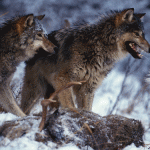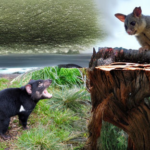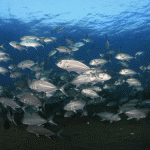
Its population has decreased dramatically within the last 10 years. Image: Shutterstock
Devil Ark is a new initiative that might save the Tasmanian devil. Will they get rid of the infamous DFTD? Will they stop extinction?
Devils were once prominent on the Australian mainland. Aboriginal rock art depicts them as far north as Kakadu, while fossil records have been found across New Guinea and Western Australia. They were wiped from the mainland by natural causes approximately 400 years ago, long before European settlers disrupted ecosystems with foreign diseases and mass clearing of habitats. Some scientists believe increasing aridity and competition from the dingo helped erode the population. But in the isolated southern state they take their name from, they thrived — until the 1930s, when they came into increasing conflict with humans, who were building towns and setting up farms.
Tasmania’s population of devils has suffered a catastrophic depletion rate caused largely by the widespread infection of Devil Facial Tumour Disease (DFTD), a contagious cancer that can be passed from devil to devil through biting. The infamous disease was first identified in 1996 in Mount William National Park (Northeast Tasmania), although there are suspicions that it may have existed for a year or two prior to this. When the disease first emerged, there were about 250,000 Tasmanian devils in the wild; by 2009, this number had dropped to less than 50,000. In some areas where the disease is rife, the populations have dropped by up to 90%. Scientists now believe reversing nature’s path might be the creature’s last hope.
Devil’s playground
On January 18, 2011, the first Tasmanian devils arrived from quarantine at Devil Ark in Barrington Tops, New South Wales. Devil Ark consists of a 350-hectare area with large “˜free range’ pens for the animals. It is described by John Weigel, founder of Devil Ark and director of the Reptile Park, as “the most Tasmanian-like chunk of mainland that there is.” These carnivorous marsupials will live here as an insurance against the worst case scenario — the extinction of the devil in Tasmania — and they will only be released back into the wild when there is no risk of DFTD.
The idea of Devil Ark was born in 2006 at the Australian Reptile Park, Sydney. The Australian Reptile Park has been involved in many conservation projects before, but none of them really caught John’s eye until now. “With Tassie devils you have such a different story. An insurance population is an absolute no brainer.”
Devil Ark is part of the Save the Tasmanian Devil Program (STTDP), an initiative of the Tasmanian government coordinated by the IUCN, the Australian Organisation Zoo and the Aquarium Association (ZAA). STTDP aims to establish captive “˜insurance’ populations of devils across Australia, commencing with the animals currently held in 18 zoos and fauna parks across Australian territory.
To maintain the genetic diversity of the devil population, it is estimated that Devil Ark needs an effective population of 500 devils, which can translate as 2,000 or more in intensive conditions. Traditional zoo programs have always concentrated on intensive management, which is extremely expensive, costing between $4,000 (at the Reptile Park) and $20,000 per animal every year. Breeding animals in zoos also stymies social interactions, Weigel explains, which can affect the whole breeding process. Devil Ark will focus on a larger number of devils in bigger pens, with the new challenge of coordinating who is breeding with whom. “(We) need to learn how to breed Tassie devils in free range enclosures.”
Kim Nolan from Save the Devil says there are currently 277 animals in captivity at the last count (during the last breeding season) and there is a new breeding season beginning soon. “A lot of people have the idea that we have to get as many devils as possible.” But it’s going to be a long-term project, as the animals may be in captivity for 50 years. Nolan hopes that in half a century the disease in the wild population has resolved itself one way or another, but it could still be a long and expensive wait for the devils. So, according to Nolan, it’s better to have the numbers needed and be able to manage this effectively, rather than overload the resources.
Devil Ark is working hard to ensure that DFTD doesn’t cross Bass Strait with the devils. The animals that make it to Australia’s mainland have spent a year in quarantine in Tasmania to ensure that none of them have the disease. It’s a pretty safe bet that any infected animals will be detected, as it takes a maximum of three months for the disease to manifest after the animal has been bitten. At Devil Ark they will be taken and put into groups of four to eight, so if the disease has managed to get through, it can’t spread between the pens. In the worst case scenario the infected animal can be removed and the others in the pen will be placed in quarantine.
Unsightly problem
DFTD is one of the only cancers known to be transmitted like an infectious disease. Due to the very low genetic variation amongst the devils, infected animals act as organ donors, passing the tumour cells to healthy animals when fighting or mating. Associate Professor Katherine Belov, from the University of Sydney, says “The tumour is essentially like an organ transplant or a skin graft.” DFTD originally evolved from a healthy Tasmanian devil, so the disease is recognised as self rather than foreign. This has affected some populations more than others due to differences in the histocompatibility complex (MHC) genes, which help prevent the rejection of organ transplants in humans. So far, the cancer can only survive in the body of a devil, as other animal’s immune systems, such as quolls, recognise the Tasmanian devil cancer cells as foreign to their bodies and destroy them.
The devil’s lifestyle also plays an important role in the transmission of the disease. Paul Andrews, from Taronga Zoo and the Tasmanian Devil Insurance Breeding Program Action Group for the Zoos and Aquarium Association (ZAA), points out that the aggressive feeding and mating habits allow the cancer cells to be exchanged. The devils also feed at “˜communal carcasses,’ so the “cancer cells are dribbled into carcasses.” Juvenile devils aren’t at as much risk of the disease, because they don’t usually begin mating until they are 14 to 16 months. Once the disease has been passed on, the infected animal will show symptoms in a few months. It will develop small lesions or pimples in the mouth that will grow into large tumours that grossly distort the mouth. The devils find it hard to eat or drink and die from dehydration and starvation within three months of the appearance of the first symptoms. The cancer can also spread throughout the devil’s body, causing organ failure and the breakdown of other important bodily functions. In 2008 researchers realised the disease had evolved into a number of strains that could move through the devil populations. The disease has had a lower impact on the resistant populations, but there are signs that this resistance might be causing the tumour to evolve. The extinction of the devil would probably result in the extinction of the disease, but there may be remaining enclaves, which could mean holding the insurance populations on the mainland longer than expected.
Foreign invaders
If the Tasmanian devil disappears, a lot of other animals will follow. The devil plays an important ecological role across a number of habitats in Tasmania. Over on the mainland, the red fox is the largest predator, consuming a diet of native rats, possums, wallabies, bilbies and numbats. They don’t feed on bigger prey such as kangaroos, which puts pressure on the smaller mammals while reducing pressure on the larger mammals and throws the ecosystem out of balance.
Until recently, the foxes had not managed to get a foothold on Tasmania and, while feral cats and dogs are present in the island, they have not established themselves as a threat the way they have on the mainland. Many scientists are attributing these low feral numbers in Tasmania to the existence of the devil. But ever since the devil populations started declining the numbers of foxes, feral cats and dogs have increased.
The animals most at risk from a feral invasion are the small mammals, with a body mass of five kilograms or less. Tasmania has a lot of native fauna, including the eastern quoll, the spotted tail quoll, the eastern barred bandicoot, the little pygmy possum, the long nosed potoroo and the Tasmanian bettong. But Weigel says if the devil dies out, it will be easy for introduced predators such as cats, dogs and foxes to take its place. “We’re going to lose those slow moving easy targets and we’re going to lose a whole lot of fauna.”
A numbers game
One of the big challenges for the conservationists is the low genetic diversity in the Tasmanian devil population. Scientists need to find a way of keeping the diversity of the devils as high as possible; otherwise the extinction of the devil is merely being postponed. ZAA originally aimed to retain 90% of diversity over 10 years, but when they realised how low the devil diversity was, they changed this to 95% over 50 years. This translates to an effective population of 500 devils in captivity.
Belov believes that a lot of genetic diversity might have already been lost to diseases or other threats. “There have been major population crashes in the past and we don’t know what caused them.” In the past the devils with the MHC gene have survived these crashes, but this time around their genes are working against them. Andrews also believes that the devil population has already been through a number of “˜bottlenecks’, such as the arrival of Europeans in Tasmania and the reduction of devil numbers until 1941, when it was made a protected species. When the population comes out the other side of a bottleneck, there is less genetic diversity, which lowers the chances of individuals in the population that are able to respond to a threat. “When your populations get small they become vulnerable.”
Keeping larger populations of devils in bigger areas should increase the numbers, but there is still a need to maintain a healthy gene flow, as inbreeding generally results in lower fertility and higher mortality
in individuals. Andrews says there are currently two techniques being employed by ZAA to manage
gene flow — scientists can either retrospectively determine the paternity of the devil or the animals can be moved between the paddocks to avoid inbreeding. This isn’t as effective as intensive management, but it’s more effective than in the wild. Andrews admits we won’t get 95% of the diversity of the Tasmanian devil population from 1,000 years ago, but if the numbers of devils increase, their genetic diversity should improve with them. It’s definitely a numbers game now, but the more individuals we have spread out over Australia in insurance populations, the better the chances that the Tasmanian devils will survive.
This article was published in our March/April 2011 issue. Visit Devil Ark to get more information about the program.






